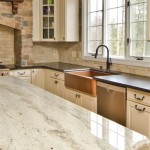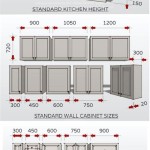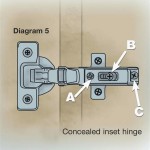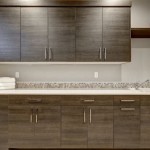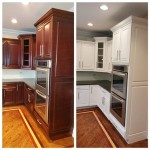Troubleshooting Kitchen Cupboards That Won't Close Properly
A kitchen cupboard that refuses to close completely is more than just an aesthetic nuisance. It can lead to a variety of problems, including attracting pests, allowing dust and grime to accumulate inside, and potentially causing damage to the cupboard itself and surrounding cabinetry. Diagnosing the root cause of this issue is crucial for implementing the appropriate solution and restoring the functionality and appearance of the kitchen.
Several factors can contribute to a cupboard's inability to close properly. These can range from simple misalignments and obstructions to more complex structural problems. A systematic approach to identifying the problem is the most efficient way to determine the necessary steps for repair.
Identifying Common Obstructions and Misalignments
The first step in addressing a cupboard that won't close involves a thorough visual inspection, both inside and outside the cabinet. Look for any obvious obstructions that might be preventing the door from fully closing. Common culprits include items that have shifted on shelves, food containers that are too tall, or cleaning supplies that are protruding from the shelf edge. Removing these obstructions is often the simplest and quickest solution.
Examine the hinges closely. Are they visibly bent, broken, or loose? Loose screws in the hinge plates are a frequent cause of misalignment. Try tightening the screws. If the screw holes are stripped, consider using a toothpick and wood glue to fill the holes before re-inserting the screws. This will provide the screws with a better grip. Allow the glue to dry completely before testing the door.
Pay attention to the alignment of the cupboard door with the frame. Is there a noticeable gap on one side while the other side is tightly closed? This suggests a misalignment issue. Misalignment can also occur if the cabinet frame itself is not perfectly square. Use a level to check the frame and ensure it is plumb and square. If the frame is out of alignment, it may require more extensive repairs or adjustments.
Sometimes, the strike plate – the metal plate where the latch catches – may be misaligned. This can prevent the door from latching properly, even if the door itself is aligned correctly. Examine the position of the strike plate in relation to the latch on the door. If they are not properly aligned, the strike plate needs to be adjusted. Loosen the screws holding the strike plate, reposition it slightly, and then re-tighten the screws. Test the door to see if it now latches correctly.
Check for any swelling or warping of the cupboard door or frame. Moisture can cause wood to swell, leading to binding and difficulty in closing. This issue is more common in areas with high humidity or where there has been water damage. In severe cases, the affected wood may need to be replaced. For minor swelling, allowing the wood to dry out completely may be sufficient. Consider using a dehumidifier in the kitchen to reduce moisture levels.
Addressing Hinge Issues
Hinges are a critical component of cupboard functionality, and problems with hinges are a common reason for closing difficulties. As mentioned, loose screws are a frequent issue. Before resorting to more drastic measures, ensure that all hinge screws are securely tightened. If the screws consistently loosen over time, consider using longer screws or screws with a larger diameter to provide a more secure hold.
Bent or broken hinges require replacement. Replacing a hinge is a relatively straightforward task, provided you can find a suitable replacement hinge that matches the existing one in size and style. Remove the old hinge by unscrewing it from the door and the frame. Install the new hinge in the same location, using the existing screw holes if possible. Ensure the new hinge is properly aligned before tightening all the screws.
Sometimes, the hinge itself may be binding or sticking. This can be due to dirt, grime, or corrosion. Try lubricating the hinge with a lubricant such as WD-40 or silicone spray. Apply the lubricant sparingly and work the hinge back and forth to distribute the lubricant evenly. Wipe away any excess lubricant to prevent it from attracting dust and grime.
For older cabinets with traditional hinges, consider replacing them with self-closing hinges. Self-closing hinges are designed to automatically pull the door closed, ensuring that it latches securely. This can be a convenient upgrade that eliminates the need to manually push the door closed.
When replacing hinges, it's crucial to use the correct type of hinge for your cabinet. There are various types of hinges available, including butt hinges, concealed hinges, and overlay hinges. Choosing the wrong type of hinge can lead to installation difficulties and improper door alignment.
Dealing with Warped Doors and Frames
Warping of cupboard doors or frames is a more serious issue that can be challenging to resolve. As previously noted, moisture is the primary cause of warping. If the warping is minor, it may be possible to correct it by drying out the wood and applying a weight to force it back into shape. This method is more effective with solid wood doors than with veneer doors.
For more significant warping, professional assistance may be required. A carpenter or cabinet maker can assess the extent of the damage and determine the best course of action. In some cases, it may be possible to plane or shave down the warped area to restore a flat surface. However, this can be a delicate process that requires specialized tools and expertise.
If the frame is warped, it may be necessary to reinforce it with additional support. This can be done by adding wooden braces or metal brackets to the frame. Ensure that the reinforcement is properly aligned and securely attached to the frame. This can help to prevent further warping and improve the stability of the cabinet.
In extreme cases, the warped door or frame may need to be replaced entirely. This is often the most effective solution for severe warping that cannot be corrected through other means. When replacing a door or frame, it's essential to choose a replacement that is made from the same material and is properly sized to fit the cabinet.
Preventative measures are crucial for minimizing the risk of warping. Keep the kitchen well-ventilated to reduce moisture levels. Avoid exposing cabinets to excessive heat or humidity. Promptly clean up any spills or water damage to prevent water from seeping into the wood. Regularly inspect the cabinets for signs of warping or damage and address any issues promptly.
Minor adjustments like shimming can also help align warped doors or frames. Shims are thin, tapered pieces of wood that can be inserted behind the hinge plates or along the frame to compensate for the warping. Experiment with different shim placements to find the optimal position for correcting the alignment.
When working with warped wood, it's important to be patient and avoid applying excessive force. Forcing the wood can cause it to crack or break. Instead, use gentle pressure and gradually work to correct the warping. If you are unsure about how to proceed, it's always best to consult with a professional.
By systematically addressing potential obstructions, hinge issues, and warping problems, individuals can often resolve common issues preventing kitchen cupboards from closing properly. A regular maintenance routine, including checking hinges and alignment, and addressing any signs of moisture damage, can help prevent future problems and prolong the life of kitchen cabinetry.

How To Adjust Your Kitchen Cupboard Doors Made Easy

How To Adjust Kitchen Cabinet Doors That Won T Close

How To Adjust Kitchen Cabinet Doors That Won T Close

How To Adjust Kitchen Cabinet Doors That Won T Close

3 Simple Ways To Adjust Kitchen Cabinet Doors Wikihow

3 Simple Ways To Adjust Kitchen Cabinet Doors Wikihow
Easy Fixes How To Fix A Cabinet Door That Won T Close Maxave

How To Adjust Soft Close Hinges 7 Steps With Pictures Wikihow
Easy Fixes How To Fix A Cabinet Door That Won T Close Maxave

How To Adjust Kitchen Cabinet Doors That Won T Close
Related Posts

